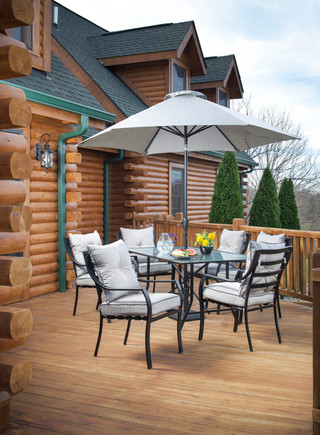However, most people live in areas that suffer rain and/or snow during the winter months. In this case, you’ll need to take extra precautions to keep your furniture in good shape and ready to use come spring and summer. Here are just a few good ways to protect your patio furniture in winter.
Place it in Storage
This is the best way to protect your outdoor furniture from the elements during the winter and keep it from rusting, rotting, or falling apart. Most people simply move their furniture into a free space like a shed, the garage, the attic, or the basement (depending on accessibility).
You might also have a rental storage space that you can transfer your patio furniture to temporarily, but this will cost money. If you can free up some space on your property, you’re going to save and keep your outdoor furniture well-maintained in the process.
Use Covers or Storage Bags
If you don’t have any open indoor space around the house in which to store your outdoor furniture, there are a couple of other options to explore. Perhaps you have some room under a deck or a porch, where at least your furniture won’t suffer the direct wrath of rain, snow, and sleet, even though it will be subject to freezing temperatures.
You can also find a variety of waterproof outdoor furniture covers and bags meant to protect your furniture from the worst of the winter weather. A cover could be as simple as a cheap tarp you get at your local hardware store. All you have to do is drape and fold it around furniture before securing it with bungee cords, zip ties, or rope. It’s not pretty, but it will generally get the job done.
Or you could spring for storage bags designed to fit standard furniture pieces (like couches, chairs, and cushions for seating). You simply finagle the furniture inside and then zip them closed for waterproof protection. These bags might be easier to manage and do a better job than your makeshift tarp method.
Either way, however, you’re going to get a higher level of protection for your outdoor furniture than you would by simply leaving it out in the elements year-round.
Treating Materials
If you want to keep your Hanover products ready for use at any time during the year, even when it’s snowing and blowing, you don’t necessarily have to remove or cover outdoor furniture during the winter. However, you do have to find ways to protect it from rust, rot, and other common wintertime deterioration.
The elements can give your outdoor furniture a beating, to be sure. How can you treat it to stand up to the moisture and freezing temperatures? You’ll have to use a variety of different preventive treatments, depending on the materials.
For example, cushions featuring outdoor fabrics are often resistant to water, sun, and other elements, and you can always add fabric protector. However, because of the cold and wetness combined, your best bet is to store plush cushions indoors during the winter so they don’t get moldy and brittle. The same goes for plastics.
As for metal or wooden patio furniture, there are a couple of options for weatherproofing. Many metal products will already be coated with some kind of protective paint to put the kibosh on rust.
You can always add your own coating, especially for wrought iron that is highly susceptible to rust, or you can apply a coat of wax to some metals (like aluminum) for additional protection in the winter. Plus, there are special oils and paints to keep wood in ship shape during wet weather.
Of course, this is not the preferred method if you don’t want to find yourself perusing an outdoor furniture sale come spring. If you want to make your patio furniture last season after season, your best bet is to protect it from harsh winter weather conditions by storing it or at least covering it appropriately.
